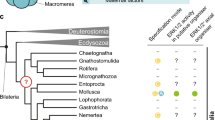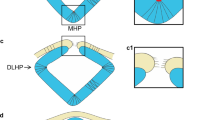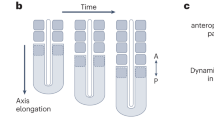Abstract
Neural induction constitutes the initial step in the generation of the vertebrate nervous system. In attempting to understand the principles that underlie this process, two key issues need to be resolved. When is neural induction initiated, and what is the cellular source and molecular nature of the neural inducing signal(s)? Currently, these aspects of neural induction seem to be very different in amphibian and amniote embryos. Here we highlight the similarities and the differences, and we propose a possible unifying mechanism.
This is a preview of subscription content, access via your institution
Access options
Subscribe to this journal
Receive 12 print issues and online access
$209.00 per year
only $17.42 per issue
Buy this article
- Purchase on Springer Link
- Instant access to full article PDF
Prices may be subject to local taxes which are calculated during checkout



Similar content being viewed by others
References
Spemann, H. & Mangold, H. Uber Induktion von Embryonanlagen durch Implantation artfremder Organisatoren. Roux. Arch. Entw. Mech. Organ. 100, 599–538 (1924).
Spemann, H. & Mangold, H. Induction of embryonic primordia by implantation of organizers from a different species. 1923. Int. J. Dev. Biol. 45, 13–38 (2001).
Hemmati-Brivanlou, A. & Melton, D. Vertebrate neural induction. Annu. Rev. Neurosci. 20, 43–60 (1997).
Ang, S. L. & Rossant, J. HNF-3 beta is essential for node and notochord formation in mouse development. Cell 78, 561–574 (1994).
Klingensmith, J., Ang, S. L., Bachiller, D. & Rossant, J. Neural induction and patterning in the mouse in the absence of the node and its derivatives. Dev. Biol. 216, 535–549 (1999).
Bachiller, D. et al. The organizer factors Chordin and Noggin are required for mouse forebrain development. Nature 403, 658–661 (2000).
Episkopou, V. et al. Induction of the mammalian node requires Arkadia function in the extraembryonic lineages. Nature 410, 825–830 (2001).
Streit, A. et al. Chordin regulates primitive streak development and the stability of induced neural cells, but is not sufficient for neural induction in the chick embryo. Development 125, 507–519 (1998).
Wilson, S. I., Graziano, E., Harland, R., Jessell, T. M. & Edlund, T. An early requirement for FGF signalling in the acquisition of neural cell fate in the chick embryo. Curr. Biol. 10, 421–429 (2000).
Streit, A., Berliner, A. J., Papanayotou, C., Sirulnik, A. & Stern, C. D. Initiation of neural induction by FGF signalling before gastrulation. Nature 406, 74–78 (2000).
Wilson, S. I. et al. The status of Wnt signalling regulates neural and epidermal fates in the chick embryo. Nature 411, 325–330 (2001).
Harland, R. Neural induction. Curr. Opin. Genet. Dev. 10, 357–362 (2000).
Streit, A. & Stern, C. D. Neural induction. A bird's eye view. Trends. Genet. 15, 20–24 (1999).
Wilson, P. A. & Hemmati-Brivanlou, A. Vertebrate neural induction: inducers, inhibitors, and a new synthesis. Neuron 18, 699–710 (1997).
Sasai, Y. & De Robertis, E. M. Ectodermal patterning in vertebrate embryos. Dev. Biol. 182, 5–20 (1997).
Waddington, C. H. Experiments on the development of chick and duck embryos, cultivated in vitro. Phil. Trans. R. Soc. Lond. B Biol. Sci. 221, 179–230 (1932).
Waddington, C. H. Induction of the primitive streak and its derivatives in the chick. J. Exp. Biol. 10, 38–46 (1933).
Kintner, C. R. & Dodd, J. Hensen's node induces neural tissue in Xenopus ectoderm. Implications for the action of the organizer in neural induction. Development 113, 1495–1505 (1991).
Storey, K. G., Crossley, J. M., De Robertis, E. M., Norris, W. E. & Stern, C. D. Neural induction and regionalisation in the chick embryo. Development 114, 729–741 (1992).
Beddington, R. S. Induction of a second neural axis by the mouse node. Development 120, 613–620 (1994).
Shih, J. & Fraser, S. E. Characterizing the zebrafish organizer: microsurgical analysis at the early-shield stage. Development 122, 1313–1322 (1996).
Waddington, C. H. Experiments on determination in the rabbit embryo. Arch. Biol. 48, 273–290 (1937).
Knoetgen, H., Teichmann, U., Wittler, L., Viebahn, C. & Kessel, M. Anterior neural induction by nodes from rabbits and mice. Dev. Biol. 225, 370–380 (2000).
Sasai, Y., Lu, B., Steinbeisser, H. & De Robertis, E. M. Regulation of neural induction by the Chd and Bmp-4 antagonistic patterning signals in Xenopus. Nature 376, 333–336 (1995).
Hemmati-Brivanlou, A. & Melton, D. A. A truncated activin receptor inhibits mesoderm induction and formation of axial structures in Xenopus embryos. Nature 359, 609–614 (1992).
Hemmati-Brivanlou, A., Kelly, O. G. & Melton, D. A. Follistatin, an antagonist of activin, is expressed in the Spemann organizer and displays direct neuralizing activity. Cell 77, 283–295 (1994).
Lamb, T. M. et al. Neural induction by the secreted polypeptide noggin. Science 262, 713–718 (1993).
Wilson, P. A. & Hemmati-Brivanlou, A. Induction of epidermis and inhibition of neural fate by Bmp-4. Nature 376, 331–333 (1995).
Grunz, H. & Tacke, L. Neural differentiation of Xenopus laevis ectoderm takes place after disaggregation and delayed reaggregation without inducer. Cell Differ. Dev. 28, 211–217 (1989).
Dale, L. & Jones, C. M. BMP signalling in early Xenopus development. Bioessays 21, 751–760 (1999).
Hawley, S. H. et al. Disruption of BMP signals in embryonic Xenopus ectoderm leads to direct neural induction. Genes Dev. 9, 2923–2935 (1995).
Xu, R. H. et al. A dominant negative bone morphogenetic protein 4 receptor causes neuralization in Xenopus ectoderm. Biochem. Biophys. Res. Commun. 212, 212–219 (1995).
Fainsod, A., Steinbeisser, H. & De Robertis, E. M. On the function of BMP-4 in patterning the marginal zone of the Xenopus embryo. EMBO J. 13, 5015–5025 (1994).
Hemmati-Brivanlou, A. & Thomsen, G. H. Ventral mesodermal patterning in Xenopus embryos: expression patterns and activities of BMP-2 and BMP-4. Dev. Genet. 17, 78–89 (1995).
Wilson, P. A., Lagna, G., Suzuki, A. & Hemmati-Brivanlou, A. Concentration-dependent patterning of the Xenopus ectoderm by BMP4 and its signal transducer Smad1. Development 124, 3177–3184 (1997).
Suzuki, A., Ueno, N. & Hemmati-Brivanlou, A. Xenopus msx1 mediates epidermal induction and neural inhibition by BMP4. Development 124, 3037–3044 (1997).
Powers, C. J., McLeskey, S. W. & Wellstein, A. Fibroblast growth factors, their receptors and signaling. Endocr. Relat. Cancer 7, 165–197 (2000).
Hongo, I., Kengaku, M. & Okamoto, H. FGF signaling and the anterior neural induction in Xenopus. Dev. Biol. 216, 561–581 (1999).
Launay, C., Fromentoux, V., Shi, D. L. & Boucaut, J. C. A truncated FGF receptor blocks neural induction by endogenous Xenopus inducers. Development 122, 869–880 (1996).
Sasai, Y., Lu, B., Piccolo, S. & De Robertis, E. M. Endoderm induction by the organizer-secreted factors chordin and noggin in Xenopus animal caps. EMBO J. 15, 4547–4555 (1996).
Lamb, T. M. & Harland, R. M. Fibroblast growth factor is a direct neural inducer, which combined with noggin generates anterior-posterior neural pattern. Development 121, 3627–3636 (1995).
Kengaku, M. & Okamoto, H. bFGF as a possible morphogen for the anteroposterior axis of the central nervous system in Xenopus. Development 121, 3121–3130 (1995).
Kroll, K. L. & Amaya, E. Transgenic Xenopus embryos from sperm nuclear transplantations reveal FGF signaling requirements during gastrulation. Development 122, 3173–3183 (1996).
Holowacz, T. & Sokol, S. FGF is required for posterior neural patterning but not for neural induction. Dev. Biol. 205, 296–308 (1999).
Ribisi, S. Jr. et al. Ras-mediated FGF signaling is required for the formation of posterior but not anterior neural tissue in Xenopus laevis. Dev. Biol. 227, 183–196 (2000).
Baker, J. C., Beddington, R. S. & Harland, R. M. Wnt signaling in Xenopus embryos inhibits bmp4 expression and activates neural development. Genes Dev 13, 3149–3159 (1999).
Vincent, J. P., Oster, G. F. & Gerhart, J. C. Kinematics of gray crescent formation in Xenopus eggs: the displacement of subcortical cytoplasm relative to the egg surface. Dev. Biol. 113, 484–500 (1986).
Miller, J. R. et al. Establishment of the dorsal-ventral axis in Xenopus embryos coincides with the dorsal enrichment of dishevelled that is dependent on cortical rotation. J. Cell Biol. 146, 427–437 (1999).
Moon, R. T., Brown, J. D. & Torres, M. WNTs modulate cell fate and behavior during vertebrate development. Trends Genet. 13, 157–162 (1997).
Christian, J. L. & Moon, R. T. Interactions between Xwnt-8 and Spemann organizer signaling pathways generate dorsoventral pattern in the embryonic mesoderm of Xenopus. Genes Dev. 7, 13–28 (1993).
Glinka, A., Wu, W., Onichtchouk, D., Blumenstock, C. & Niehrs, C. Head induction by simultaneous repression of Bmp and Wnt signalling in Xenopus. Nature 389, 517–519 (1997).
Glinka, A. et al. Dickkopf-1 is a member of a new family of secreted proteins and functions in head induction. Nature 391, 357–362 (1998).
Itoh, K., Tang, T. L., Neel, B. G. & Sokol, S. Y. Specific modulation of ectodermal cell fates in Xenopus embryos by glycogen synthase kinase. Development 121, 3979–3988 (1995).
Umbhauer, M., Penzo-Mendez, A., Clavilier, L., Boucaut, J. & Riou, J. Signaling specificities of fibroblast growth factor receptors in early Xenopus embryo. J. Cell Sci. 113, 2865–2875 (2000).
Wessely, O., Agius, E., Oelgeschlager, M., Pera, E. M. & De Robertis, E. M. Neural induction in the absence of mesoderm: beta-catenin-dependent expression of secreted BMP antagonists at the blastula stage in Xenopus. Dev. Biol. 234, 161–173 (2001).
Gamse, J. T. & Sive, H. Early anteroposterior division of the presumptive neurectoderm in Xenopus. Mech. Dev. 104, 21–36 (2001).
Penzel, R., Oschwald, R., Chen, Y., Tacke, L. & Grunz, H. Characterization and early embryonic expression of a neural specific transcription factor xSOX3 in Xenopus laevis. Int. J. Dev. Biol. 41, 667–677 (1997).
Mizuseki, K., Kishi, M., Shiota, K., Nakanishi, S. & Sasai, Y. SoxD: an essential mediator of induction of anterior neural tissues in Xenopus embryos. Neuron 21, 77–85 (1998).
Kroll, K. L., Salic, A. N., Evans, L. M. & Kirschner, M. W. Geminin, a neuralizing molecule that demarcates the future neural plate at the onset of gastrulation. Development 125, 3247–3258 (1998).
Zhang, J. & Jacobson, A. G. Evidence that the border of the neural plate may be positioned by the interaction between signals that induce ventral and dorsal mesoderm. Dev. Dyn. 196, 79–90 (1993).
Kurata, T., Nakabayashi, J., Yamamoto, T. S., Mochii, M. & Ueno, N. Visualization of endogenous BMP signaling during Xenopus development. Differentiation 67, 33–40 (2001).
Smith, J. L. & Schoenwolf, G. C. Notochordal induction of cell wedging in the chick neural plate and its role in neural tube formation. J. Exp. Zool. 250, 49–62 (1989).
Sater, A. K. & Jacobson, A. G. The role of the dorsal lip in the induction of heart mesoderm in Xenopus laevis. Development 108, 461–470 (1990).
Davidson, B. P., Kinder, S. J., Steiner, K., Schoenwolf, G. C. & Tam, P. P. Impact of node ablation on the morphogenesis of the body axis and the lateral asymmetry of the mouse embryo during early organogenesis. Dev. Biol. 211, 11–26 (1999).
Pera, E., Stein, S. & Kessel, M. Ectodermal patterning in the avian embryo: epidermis versus neural plate. Development 126, 63–73 (1999).
Sheng, G. & Stern, C. D. Gata2 and Gata3: novel markers for early embryonic polarity and for non-neural ectoderm in the chick embryo. Mech. Dev. 87, 213–216 (1999).
Schier, A. F. & Talbot, W. S. Nodal signaling and the zebrafish organizer. Int. J. Dev. Biol. 45, 289–297 (2001).
Yamaguchi, T. P., Takada, S., Yoshikawa, Y., Wu, N. & McMahon, A. P. T (Brachyury) is a direct target of Wnt3a during paraxial mesoderm specification. Genes Dev. 13, 3185–3190 (1999).
Muhr, J., Graziano, E., Wilson, S., Jessell, T. M. & Edlund, T. Convergent inductive signals specify midbrain, hindbrain, and spinal cord identity in gastrula stage chick embryos. Neuron 23, 689–702 (1999).
Streit, A. & Stern, C. D. Establishment and maintenance of the border of the neural plate in the chick: involvement of FGF and BMP activity. Mech. Dev. 82, 51–66 (1999).
Matzuk, M. M. et al. Multiple defects and perinatal death in mice deficient in follistatin. Nature 374, 360–363 (1995).
McMahon, J. A. et al. Noggin-mediated antagonism of BMP signaling is required for growth and patterning of the neural tube and somite. Genes Dev. 12, 1438–1452 (1998).
Kawasaki, H. et al. Induction of midbrain dopaminergic neurons from ES cells by stromal cell-derived inducing activity. Neuron 28, 31–40 (2000).
Levin, M. The roles of activin and follistatin signaling in chick gastrulation. Int. J. Dev. Biol. 42, 553–559 (1998).
Connolly, D. J., Patel, K. & Cooke, J. Chick noggin is expressed in the organizer and neural plate during axial development, but offers no evidence of involvement in primary axis formation. Int. J. Dev. Biol. 41, 389–396 (1997).
Knoetgen, H., Viebahn, C. & Kessel, M. Head induction in the chick by primitive endoderm of mammalian, but not avian origin. Development 126, 815–825 (1999).
Hammerschmidt, M., Serbedzija, G. N. & McMahon, A. P. Genetic analysis of dorsoventral pattern formation in the zebrafish: requirement of a BMP-like ventralizing activity and its dorsal repressor. Genes Dev. 10, 2452–2461 (1996).
Fekany-Lee, K., Gonzalez, E., Miller-Bertoglio, V. & Solnica-Krezel, L. The homeobox gene bozozok promotes anterior neuroectoderm formation in zebrafish through negative regulation of BMP2/4 and Wnt pathways. Development 127, 2333–2345 (2000).
Nguyen, V. H. et al. Ventral and lateral regions of the zebrafish gastrula, including the neural crest progenitors, are established by a bmp2b/swirl pathway of genes. Dev. Biol. 199, 93–110 (1998).
Dick, A. et al. Essential role of Bmp7 (snailhouse) and its prodomain in dorsoventral patterning of the zebrafish embryo. Development 127, 343–354 (2000).
Hild, M. et al. The smad5 mutation somitabun blocks Bmp2b signaling during early dorsoventral patterning of the zebrafish embryo. Development 126, 2149–2159 (1999).
Hsieh, J. C., Rattner, A., Smallwood, P. M. & Nathans, J. Biochemical characterization of Wnt-frizzled interactions using a soluble, biologically active vertebrate Wnt protein. Proc. Natl. Acad. Sci. USA 96, 3546–3551 (1999).
Pera, E. M. & De Robertis, E. M. A direct screen for secreted proteins in Xenopus embryos identifies distinct activities for the Wnt antagonists Crescent and Frzb-1. Mech. Dev. 96, 183–195 (2000).
Shibata, M., Ono, H., Hikasa, H., Shinga, J. & Taira, M. Xenopus crescent encoding a Frizzled-like domain is expressed in the Spemann organizer and pronephros. Mech. Dev. 96, 243–246 (2000).
Isaacs, H. V., Pownall, M. E. & Slack, J. M. eFGF is expressed in the dorsal midline of Xenopus laevis. Int. J. Dev. Biol. 39, 575–579 (1995).
Hansen, C. S., Marion, C. D., Steele, K., George, S. & Smith, W. C. Direct neural induction and selective inhibition of mesoderm and epidermis inducers by Xnr3. Development 124, 483–492 (1997).
Niehrs, C. Head in the WNT: the molecular nature of Spemann's head organizer. Trends Genet. 15, 314–319 (1999).
Stern, C. D. Initial patterning of the central nervous system: how many organizers? Nat. Rev. Neurosci. 2, 92–98 (2001).
Nieuwkoop, P. D. et al. Activation and organization of the central nervous system in amphibians. J. Exp. Zool. 120, 1–108 (1952).
Foley, A. C., Skromne, I. & Stern, C. D. Reconciling different models of forebrain induction and patterning: a dual role for the hypoblast. Development 127, 3839–3854 (2000).
Kimura, C. et al. Visceral endoderm mediates forebrain development by suppressing posteriorizing signals. Dev. Biol. 225, 304–321 (2000).
Muhr, J., Jessell, T. M. & Edlund, T. Assignment of early caudal identity to neural plate cells by a signal from caudal paraxial mesoderm. Neuron 19, 487–502 (1997).
Fukushima, M., Nakamura, M., Ohta, K., Okamura, R. & Negi, A. Regional specification of motoneurons along the anterior-posterior axis is independent of the notochord. Development 122, 905–914 (1996).
Dale, J. K. et al. Cooperation of BMP7 and SHH in the induction of forebrain ventral midline cells by prechordal mesoderm. Cell 90, 257–269 (1997).
Thomas, P. & Beddington, R. Anterior primitive endoderm may be responsible for patterning the anterior neural plate in the mouse embryo. Curr. Biol. 6, 1487–1496 (1996).
Martinez Barbera, J. P. et al. The homeobox gene Hex is required in definitive endodermal tissues for normal forebrain, liver and thyroid formation. Development 127, 2433–2445 (2000).
Roth, S., Stein, D. & Nusslein-Volhard, C. A gradient of nuclear localization of the dorsal protein determines dorsoventral pattern in the Drosophila embryo. Cell 59, 1189–1202 (1989).
St Johnston, R. D. & Gelbart, W. M. Decapentaplegic transcripts are localized along the dorsal-ventral axis of the Drosophila embryo. EMBO J. 6, 2785–2791 (1987).
Acknowledgements
T.E. is supported by the Swedish Medical Research Council and by the Foundation for Strategic Research. We thank members of the Edlund lab for helpful discussions and we are grateful to T.M. Jessell for comments, suggestions and ideas.
Author information
Authors and Affiliations
Corresponding author
Rights and permissions
About this article
Cite this article
Wilson, S., Edlund, T. Neural induction: toward a unifying mechanism. Nat Neurosci 4 (Suppl 11), 1161–1168 (2001). https://doi.org/10.1038/nn747
Received:
Accepted:
Published:
Issue Date:
DOI: https://doi.org/10.1038/nn747
This article is cited by
-
Cytoplasmic localization of GRHL3 upon epidermal differentiation triggers cell shape change for epithelial morphogenesis
Nature Communications (2018)
-
MAPK signaling is necessary for neurogenesis in Nematostella vectensis
BMC Biology (2016)
-
Epigenetic regulation of early neural fate commitment
Cellular and Molecular Life Sciences (2016)
-
Histone deacetylation promotes mouse neural induction by restricting Nodal-dependent mesendoderm fate
Nature Communications (2015)
-
Differentiation of Human Embryonic Stem Cells into Clinically Amenable Keratinocytes in an Autogenic Environment
Journal of Investigative Dermatology (2013)



